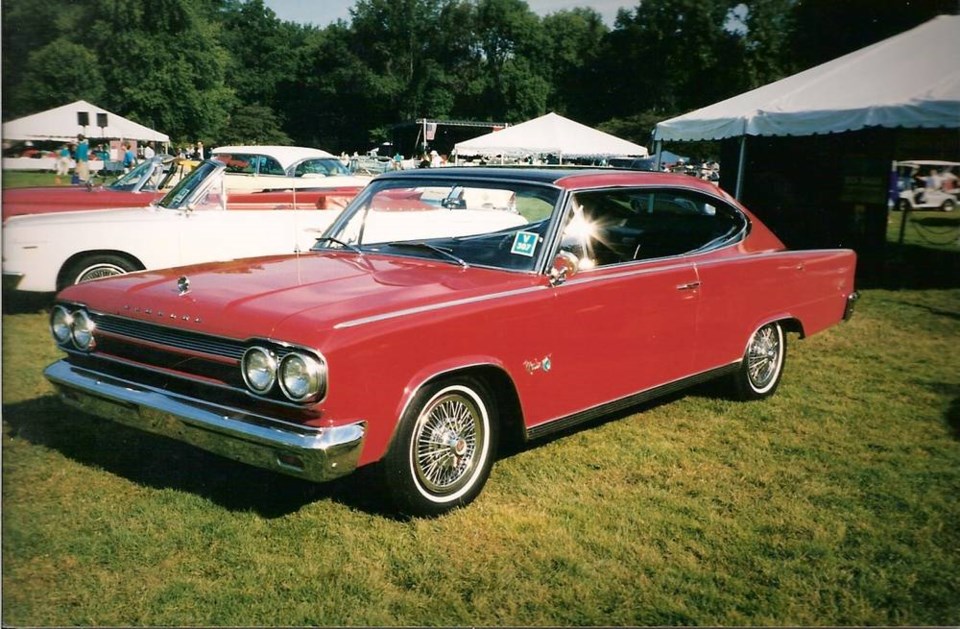Nash Motor Co. and Hudson Motor Car Co. merged to form American Motors Corp. in 1954. Nash’s designs predominated although AMC continued to market cars with both Nash and Hudson nameplates until 1957 when the Hudson and Nash names were then discontinued along with the corporation’s large cars. AMC products then became Ramblers.
During the 1950s and early ’60s AMC chairman George Romney had been a man ahead of his time. A strong advocate of smaller, more fuel efficient cars, he constantly ridiculed the “gas guzzling dinosaurs” produced by General Motors, Ford and Chrysler.
When Romney left AMC in 1962 to enter politics, which would lead to three terms as governor of Michigan and a run at the U.S. presidency, his replacement at AMC’s had different priorities. New president Roy Abernethy was an ex-Packard man who set out to burnish what he saw as AMC’s staid image.
Whereas Romney promoted a smaller, less flamboyant market niche, Abernethy wanted to challenge the Big Three with larger, more powerful and exciting cars. This would ultimately fail, but not before a variety of models emerged, among them the fastback Rambler Marlin.
In the early 1960s fastbacks enjoyed some popularity in such sporty models as the Chevrolet Corvette and Studebaker Avanti and AMC wanted to tap into this market. Chief stylist Richard Teague had already identified the trend and had developed a concept fastback version of the compact Rambler American called the Tarpon.
It was displayed at the 1964 Society of Automotive Engineers’ convention in Detroit. The sleek Tarpon was popular with the engineers, and this reaction plus favourable responses at showings in California and Chicago convinced AMC they were on the right path to take it to market.
Abernethy agreed, but with a twist. They would proceed with production but not with the Tarpon version. In the usual Detroit response Abernethy wanted something bigger, a fastback version of the company’s mid-size Rambler Classic. It would be a kind of 3+3 configuration rather than the usual sporty 2+2.
Teague created the new car which they called the Rambler Marlin, based on the larger Rambler Classic. But what had looked nicely proportioned on the 2,692 mm (106 in.) Rambler American wheelbase took on a different character on the Classic’s longer 2,845 mm (112 in.).
Whereas the Tarpon’s 1,333 mm (52.5-in.) height and 4,572 mm (180 in.) length had given it a svelte, smooth appearance, the Marlin’s 38 mm (1.5 in.) greater height and 381 mm (15 in.) more length made it look long and ungainly in comparison.
The Marlin was neither a compact sporty fastback nor a regular six passenger sedan. The newly identified youth market it was intended to attract weren’t interested in a huge, six passenger car. And since family car buyers preferred four doors and large trunks, the Marlin was a little like a fish out of water looking for its market niche.
It didn’t bring much mechanical excitement either. Although the Marlin’s base AMC 3.8 litre (232 cu in.), 145 horsepower overhead valve inline six was reliable and sturdy, it was about as prosaic as they came.
Optional overhead valve 4.7 and 5.4 litre (287 and 327 cu in) 198 and 270 horsepower V-8s offered more excitement, but that tinge of adventure was cancelled by the fact that the Marlin came with only an automatic transmission, a serious deficiency in the sporty market segment.
AMC introduced the Marlin as a mid-1965 model and it generated an initial flush of interest. In spite of being only a half-year model a surprising 10,327 ’65s were sold.
There was little change in the 1966 Marlin, and interest in AMC’s fastback plunged. Only 4,547 found buyers; apparently almost those who wanted a Marlin had bought one in 1965.
Something was needed to rejuvenate it so Teague was asked to have another try at the corporate shell game by basing the 1967 Marlin on the company’s even larger Ambassador model.
This resulted in a 152 mm (6.0 in.) longer wheelbase of 2,997 mm (118 in.). And at 5,118 mm (201.5 in.) long it was 165 mm (6.5 in.) longer over all. The Marlin that had been big before was even bigger now.
Surprisingly, the increase made the Marlin better proportioned and it seemed to generate some new interest. It didn’t translate into many sales however, in spite of such available options as 280 horsepower, a tachometer, disc brakes, and a four-on-the-floor manual transmission, only 2,545 ’67s were sold.
“Longer, lower and wider” didn’t revive the market for the bigger Marlin, and AMC’s attempt at an oversize sporty car ended in 1967.
The Marlin was gone and so was Abernethy, and AMC wisely turned its fastback attention to the far more successful Javelin pony car.



